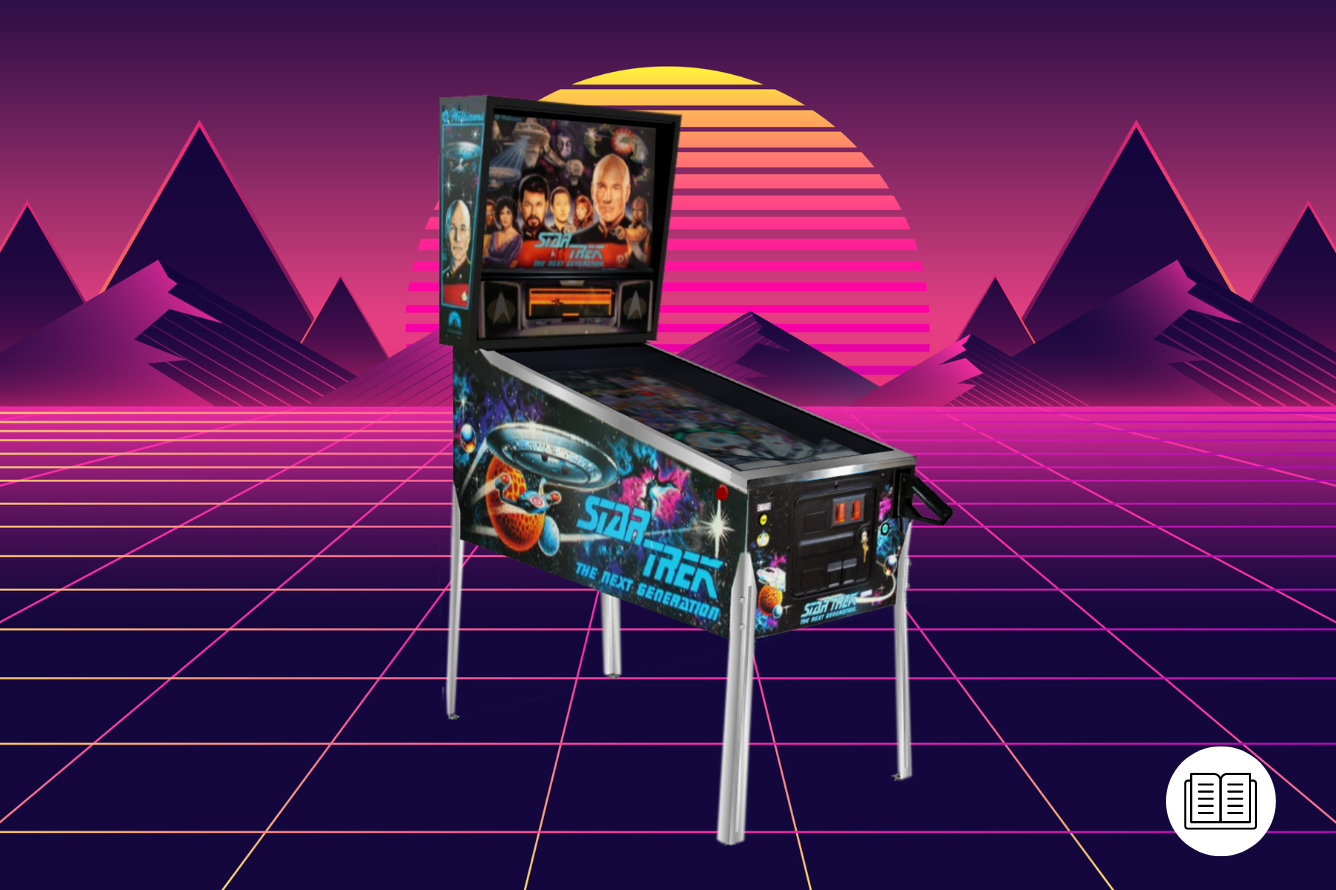Star Trek: The Next Generation had many licensed products generating income for Paramount. Among the successes was the pinball table from Williams, created by legendary designer Steve Ritchie.
Steve was a Star Trek fan. “I was 16 when the series started. It ran on Saturday nights; I would stretch out on the family room carpet and never leave that position until it was over! Saturday night was Western night before Star Trek, so the early Star Trek episodes had a lot of Kirk and Spock fighting and shooting scenes to compete with Bonanza, Gunsmoke, Have Gun Will Travel, and The Rifleman. I always loved sci-fi books and there was only a couple of sci-fi shows on TV at the time. I watched Twilight Zone, Outer Limits, and Science Fiction Theater. Star Trek was a better and more welcome addition to our house. My whole family loved it.”
Liking the show did not make it easier to obtain the license. “Our first meeting with the folks at Paramount did not go well at all. What made it difficult was the fact that three women ran the licensing department at Paramount. They seemed to be of equal rank, and they were trying to outdo each other in an attempt to grab power. To our astonishment, they demanded that we NOT depict any weapons or physical violence, no firing of Phasers or Photon Torpedoes! They did not know about the Prime Directive, but we did, and we vowed that no shooting would take place except in certain battles (against the Borg) and only when Starfleet personnel were protecting themselves or Enterprise. They wouldn’t hear anything we said!”

It would not have been the first Star Trek pinball, although Gottlieb’s Star Trek (1971) was unrelated to the show. Bally’s 1976 Star Ship featured artwork that looked like Enterprise. Bally launched Star Trek (based on the Original Series) in 1979. With the release of Star Trek: The Motion Picture, the backglass artwork (where the score is usually displayed) was changed to display movie uniforms and Deltan navigator Ilia (played by former Miss India, Persis Khambatta). Then in 1991, Data East released its 25th Anniversary table.
Up Close with Star Trek: The Next Generation
Steve had left that first meeting disappointed. “I had nothing to say after the meeting. We walked to the Paramount commissary and sat down for lunch. I remember feeling miserable and wondering to myself, ‘How could the licensing people have been so hypocritical!’ One of the licensing ladies said something to the effect that we should remember their demands for no violence, and I said, ‘I am not going to make a namby-pamby game’ and mentioned that we should find a different license. Paramount stood to get $100,000 upfront and a royalty for each game from Williams. It was expensive and valuable. We left the lot silently and got on a plane back to Chicago.”
Their savior was Roger Sharpe. His 1976 testimony proved pinball was a game of skill, the judge overturned New York’s pinball ban. By 1991 Roger was a consultant to Williams. “Roger was instrumental in repairing the situation. He waited a week, then called a VP at Paramount. His exact words were, ‘How can we salvage this deal?’ We learned that Paramount management was furious with the three licensing ladies, and they had had enough of their infighting. They knew nothing about the product. The ladies were replaced by a smart and nice woman named Suzy Domnick. She was wonderful to work with, understood that we would do nothing to hurt the franchise, and said that we could depict violence as was depicted in the show.”

“On our next trip to Hollywood, we met Michael Okuda, Dan Curry, and Mike Westmore, and got a complete tour of the sound stages. We were shown so much cool stuff that it was mind-boggling. We watched a scene being shot with Gates McFadden in Sick Bay, stood on the Enterprise transporter, and walked onto the ship’s bridge set just as Patrick Stewart and the rest of the crew did! We also chatted with Kelsey Grammer and Kirsty Alley, both genuinely nice normal people.
“We ate at the commissary that day and Patrick Stewart sat down right behind me, speaking with his agent. That voice of his was electrifying. Paramount had a rule: Visitors were not to speak to actors unless we were spoken to. I don’t know what I would have said to him anyway!”
Paramount was more helpful during production. Steve remembers, “They supplied lots of references, but did not insist on anything, really. We got to do what we needed to do to make a good pinball machine. Outside entities can’t control our designs, ever. We don’t try to make movies or TV shows because we don’t know how. They can’t make good pinball machines because no outside entity knows how. They did have art approval rights but were neither strict nor difficult. It was smooth sailing after Paramount hired Suzy Domnick. We became respectful friends, and of course, enjoyed our joint success in the end.”
Designing The Next Generation Pinball
Steve, often called ‘The King of Pinball,’ was a master of innovative ideas. The ‘phaser’ ball launcher, spaceship models, and artwork make a fantastic-looking table. Steve explains, “Many items were designed from scratch, and that’s true for every game I have ever made. The subterranean troughs and diverter system were worthy of a patent.” These are unseen by the player, rerouting the ball under the playfield.
“I also designed the Ferengi targets that scored and forced the ball downward into the playfield at the Neutral Zone, the Photon Torpedo cannon covers, the Borg ship, and its many contained functions, and lots of other components.”
Steve had joined Atari as employee #50 in 1974, working in assembly before joining the pinball division. His first table became Airborne Avenger (1977) and was working on a licensed Superman table when Williams approached him. Moving to Chicago, Flash (1979) sold a massive 19,000 units. 1980 saw Firepower, featuring the first electronic multiball and Lane Change features. Black Knight introduced a two-level playing field and Magna-Save (a button activates a magnet, stopping the ball from draining if timed correctly.) Both were noteworthy for including speech. 1981’s Hyperball was followed by five years working on video games at his company King Video Design. Steve returned to pinball with 1986’s High Speed, followed by Black Knight 2000 and Rollergames (based on a canceled TV show). Other titles included Getaway and F14 Tomcat, and he helped on Elvira and the Party Monsters when designer Dennis Nordman suffered a motorbike accident. The next hit was Terminator 2: Judgement Day, with the voice of Arnold Schwarzenegger.

The Next Generation was part of Williams’ SuperPin “widebody” range, incorporating the DCS sound system and dot-matrix display. Launching the ball with the phaser, the display shows a shifting list of options; launching on Start Mission will activate the current mission indicated on Enterprise-D’s saucer section. Completing the mission awards an Artifact. Asteroid requires hitting bumpers to destroy asteroids, Battle Simulation uses the Photon Torpedo launchers, and Q’s Challenge sees the omnipotent menace challenging you to make certain shots. Rescue requires saving people by hitting the center shot or lit ramp, and loading the shuttle or transporter. Search the Galaxy, Time Rift, and Wormhole all use the ramps (labeled as four galaxy Quadrants). Shuttle Simulation is Video Mode, weaving through caves on the dot-matrix display. Locking the ball three times leads to combat against the Borg, with the enemy “ship” firing the ball at the flippers.










